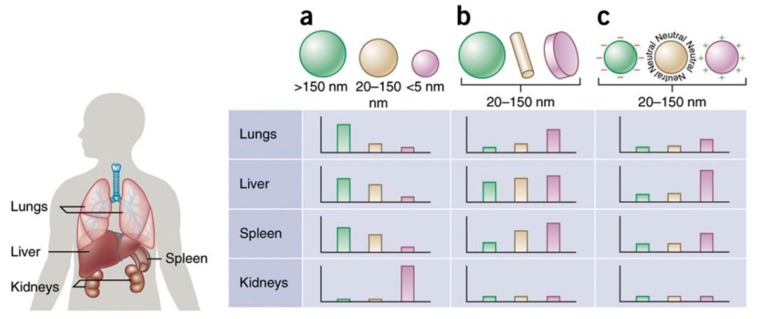Figure 5.
Nanoparticle size, shape and surface charge dictate biodistribution among the different organs including the lungs, liver, spleen and kidneys. (a) Spherical particles, including gold/magnetic nanoparticles, liposomes and polymeric micelles/NPs can vary in size and display disparate in vivo fates. Large rigid particles with diameters > 2000 nm accumulate readily within the spleen and liver, as well as in the capillaries of the lungs. Nanoparticles in the range of 100–200 nm have been shown to extravasate through vascular fenestrations of tumors (the EPR effect) and escape filtration via liver and spleen. As size increases further than 150 nm, extra NPs are captured within the liver and spleen. Small-sized NPs (<5 nm) are filtered out by the kidneys. (b) Novel 'top-down' and 'bottom up' fabrication tools have allowed the investigation of various geometries of NPs, including cylindrical and discoidal shapes, which have been shown to demonstrate distinct effects on pharmacokinetics and biodistribution. Various NPs shapes show exclusive flow characteristics that significantly change circulating lifetimes, cell membrane interactions and macrophage uptake, which in turn manipulate biodistribution between the different organs. (c) Charge of NPs stemming from distinct surface chemistries influences opsonization, circulation times, and interaction with local macrophages of organs comprising the mononuclear phagocytic system (MPS), with positively charged particles more prone to sequestration by macrophages in the lungs, liver, and spleen. Neutral and a little negatively charged NPs have longer circulation lifetimes and lower accumulation in the above mentioned organs of the MPS. In both b and c, the size of the NPs is in the range from 20–150 nm. Individual panels correspond to in vivo fates of NPs, taking into account singular design parameters of size, shape, and surface charge independent of one another, and for this reason, respective scales differ from one panel to the next. It is vital to note that in vivo biodistribution will vary based on the interaction of various these parameters. The figure and figure caption was reproduced and adapted from [110] after permission from NPG, respectively.

